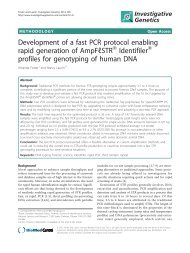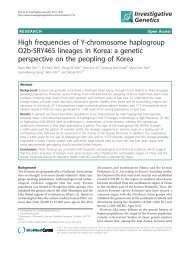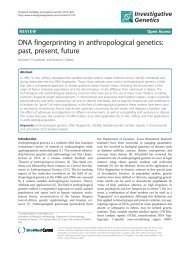Purification of crime scene DNA extracts using centrifugal filter devices
Purification of crime scene DNA extracts using centrifugal filter devices
Purification of crime scene DNA extracts using centrifugal filter devices
Create successful ePaper yourself
Turn your PDF publications into a flip-book with our unique Google optimized e-Paper software.
Norén et al. Investigative Genetics 2013, 4:8 Page 2 <strong>of</strong> 8<br />
http://www.investigativegenetics.com/content/4/1/8<br />
Background<br />
Biological samples from <strong>crime</strong> <strong>scene</strong>s are heterogeneous, as<br />
any human cell type deposited on any material or surface can<br />
be recovered and used as evidence. Forensic <strong>DNA</strong> analysis is<br />
limited by the size, quality and purity <strong>of</strong> these samples. Efficient<br />
sample treatment protocols are needed to release and<br />
concentrate the nucleic acids and remove PCR-inhibitory<br />
compounds, thus maximizing the analytical success rate [1,2].<br />
Sample treatment generally includes i) eluting cells from<br />
evidence item, swab or mini-tape, ii) cell lysis, and<br />
iii) <strong>DNA</strong> purification. In this process, there is generally a<br />
trade-<strong>of</strong>f between yield and purity. Physical separation <strong>of</strong><br />
cells from the background material prior to lysis, for<br />
example, by laser microdissection or differential centrifugation<br />
methods [3,4], can improve sample purity. However,<br />
these methods are timeconsuming, laser microdissection<br />
is very costly and differential centrifugation generally gives<br />
poor recovery rates (below 50%) [5]. Direct lysis is more<br />
straightforward and generates higher yields, and has therefore<br />
become the most common approach in forensics [6].<br />
Cell lysis can be chemical (for example, <strong>using</strong> detergents),<br />
enzymatic (for example, proteinase K treatment), physical<br />
(for example, heating) or mechanical (for example, beadbeating).<br />
Direct lysis involves the obvious risk <strong>of</strong> coextracting<br />
disturbing substances with physicochemical<br />
properties similar to <strong>DNA</strong>. Extensive <strong>DNA</strong> purification can<br />
therefore be needed to generate PCR-compatible <strong>extracts</strong><br />
[7-9]. <strong>DNA</strong> purification, however, inevitably leads to <strong>DNA</strong><br />
loss [10,11]. The level <strong>of</strong> loss is dependent on both sample<br />
type and purification method. Recovery rates spanning<br />
from 10 to 85% have been reported when comparing different<br />
methods for a certain sample type [10].<br />
Post-extraction <strong>DNA</strong> purification <strong>of</strong> <strong>crime</strong> <strong>scene</strong> samples<br />
is generally performed <strong>using</strong> kits based on silica-coated<br />
magnetic beads or silica membranes in manual or automated<br />
protocols [12,13] or applying <strong>centrifugal</strong> <strong>filter</strong> <strong>devices</strong><br />
[8,14,15]. Centrifugal <strong>filter</strong> <strong>devices</strong>, or microdialysis,<br />
have been applied in forensics since the early days <strong>of</strong> PCRbased<br />
<strong>DNA</strong> analysis [14].<br />
Lately, the forensic application <strong>of</strong> the Amicon Ultra<br />
(Millipore, Billerica, MA, USA) <strong>filter</strong> device has been<br />
reported in several studies, for purification as well as for<br />
concentration <strong>of</strong> <strong>DNA</strong> <strong>extracts</strong> [16-20]. However, there is<br />
a lack <strong>of</strong> studies investigating the recovery rate and general<br />
performance <strong>of</strong> this and other <strong>centrifugal</strong> <strong>devices</strong> for<br />
common <strong>crime</strong> <strong>scene</strong> sample types. The recent introduction<br />
<strong>of</strong> new short tandem repeat (STR) <strong>DNA</strong> typing kits<br />
with increased PCR inhibitor tolerance [21,22] also make<br />
it relevant to update the view on <strong>DNA</strong> purification. We<br />
have evaluated the recovery rate and purification capacity<br />
<strong>of</strong> the <strong>centrifugal</strong> <strong>filter</strong> <strong>devices</strong> Amicon Ultra 30 K and<br />
Microsep 30 K (Pall, Port Washington, NY, USA) and<br />
compared their respective performance in long-term<br />
routine use.<br />
Methods<br />
Amicon Ultra 30 K and Microsep 30 K were evaluated<br />
<strong>using</strong> dilution series <strong>of</strong> extracted <strong>DNA</strong> and mock <strong>crime</strong><br />
<strong>scene</strong> <strong>DNA</strong> <strong>extracts</strong> from various sample types and extraction<br />
procedures. The non-purified <strong>DNA</strong> <strong>extracts</strong> were<br />
first quantified and in some cases STR-analyzed (see<br />
below) and used as references for calculation <strong>of</strong> recovery<br />
rates. Each extract was split between the two <strong>devices</strong>,<br />
Amicon Ultra 30 K and Microsep 30 K, and purified in<br />
parallel to achieve the most accurate comparison regarding<br />
recovery rate and general performance. Additionally,<br />
the performance <strong>of</strong> the two <strong>filter</strong> <strong>devices</strong> was compared in<br />
long-term use in routine casework. In total, 7,869 casework<br />
<strong>DNA</strong> <strong>extracts</strong> were evaluated with respect to level<br />
<strong>of</strong> PCR inhibition and STR results, <strong>of</strong> which 4,883<br />
were purified <strong>using</strong> Amicon Ultra 30 K and 2,986 <strong>using</strong><br />
Microsep 30 K.<br />
Preparation <strong>of</strong> <strong>DNA</strong> for investigation <strong>of</strong> recovery rates<br />
Pure <strong>DNA</strong> was prepared for the recovery rate study.<br />
<strong>DNA</strong> extracted from whole blood <strong>using</strong> BioRobot M48<br />
(Qiagen, Hilden, Germany) was quantified (see below)<br />
and diluted to 2.0, 0.5, and 0.2 ng/μL. Five 200 μL replicates<br />
per concentration and type <strong>of</strong> <strong>filter</strong> device (Amicon<br />
Ultra 30 K and Microsep 30 K) were analyzed. One wash<br />
cycle was applied in the <strong>filter</strong> purification (see below).<br />
All <strong>extracts</strong> were quantified before and after <strong>centrifugal</strong><br />
<strong>filter</strong> purification.<br />
Preparation <strong>of</strong> <strong>DNA</strong> from mock <strong>crime</strong> <strong>scene</strong> stains<br />
<strong>DNA</strong> <strong>extracts</strong> were prepared for various mock <strong>crime</strong> <strong>scene</strong><br />
sample types. All extractions were performed <strong>using</strong> Chelex<br />
[23], except where other methods are indicated. The<br />
samples were quantified and STR-analyzed (see below).<br />
For blood on denim, blood (20 μL <strong>of</strong> diluted blood corresponding<br />
to 2 μL <strong>of</strong> whole blood) was placed on<br />
0.5 × 0.5 cm pieces <strong>of</strong> denim fabric and left to dry (three<br />
samples). For blood on paper, 10 samples <strong>of</strong> blood on kitchen<br />
paper (30 μL <strong>of</strong> diluted blood corresponding to 3 μL<br />
whole blood on 0.5 × 0.5 cm pieces <strong>of</strong> paper) were left to<br />
dry before performing organic (phenol) extraction [24].<br />
For hair, 10 anagen hairs were cut 0.5 cm from the root<br />
and each hair was placed in a 1.5 mL microcentrifuge tube<br />
with hair buffer for Chelex extraction. For rape case samples,<br />
24 samples with both semen (1 μL <strong>of</strong> semen in 30 μL<br />
water) and saliva (80 μL <strong>of</strong> mouth rinse, from 5 mL <strong>of</strong> tap<br />
water rinsed for one minute, added to mimic the epithelial<br />
fraction <strong>of</strong> sex-<strong>crime</strong> samples) were prepared on cotton<br />
swabs and left to dry before extraction <strong>using</strong> Chelex-based<br />
differential lysis extraction, generating 24 semen and 24<br />
epithelial cell fractions. For saliva on envelopes, the envelopes<br />
were sealed with saliva and left to dry, and 1 × 1.5<br />
cm pieces <strong>of</strong> the adhesive edges were cut and divided into<br />
six equally sized strips prior to extraction (three samples).





